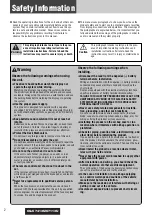
When a call is transferred using this service code, it is transferred to the ring group destination for that
incoming trunk. For example, trunk 2 is in Ring Group 4. When the call is transferred using this service
code, the trunk rings all extensions programmed for Ring Group 4 or rings the External Paging Group
for Ring Group 4, depending on how the system is programmed.
PRG 22-04-01: Extension Ring Group Assignment and PRG 22-05-01: Incoming Trunk Ring Group
Assignment must be programmed to allow an extension access to the ring groups. If the call is not
answered, it can overflow to the destination defined in PRG 22-08-01: DIL/IRG No Answer
Destination.
This service code can also be used with the VRS. This provides the caller listening to the VRS
message with the ability to transfer their call and have it ring the external page. The code the caller
would dial is defined in PRG 25-06-02: VRS/DISA One-Digit Code Attendant Setup.
Transfer Key Can Place Call on Hold
While on a call, and
Transfer
key is pressed, the call is placed on hold.
Conditions
• An existing call can be transferred into a call with Barge-In enabled.
• Unscreened Transfers from voice mail show pre-answer Caller ID information.
• With Transfer to Busy Extensions enabled (PRG 24-02-01 = 1), Call Forwarding with Both Ringing
offers a unique option. A transferred call waits for either the forwarding or destination extension to
become free. The call goes through to the extension that first becomes available. If neither
extension becomes free in the Transfer Recall Time, the call recalls the transferring extension.
With Transfer to Busy Extensions disabled (PRG 24-02-02 = 0), you must also set PRG 20-09-07 for the
extensions COS to 0 to disable call queuing and PRG 20-13-06 to set Automatic Off-hook Signaling to
manual.
• An existing call can be transferred into a conference call.
• Meet Me Paging Transfer allows the user to page a co-worker and have the call automatically
transferred when the co-worker answers the page.
• When transferring, an extension user can press a One-Touch key instead of dialing the extension
number.
• Serial calls allow for transferring a call so it automatically returns to the transferring extension when
completed.
• When a Multiline Terminal user is on a call, they can transfer to another station by pressing a DSS
key for that station. It is not necessary to press
Transfer
key to transfer to another station with a
DSS key.
When a Multiline Terminal user is on a call, they must press Transfer key to transfer a call off site with
a DSS key.
• The following features require certain tones be changed in PRG 80-01-02. Refer to the table in the
InMail feature programming section for settings:
- Call Holding
- Busy Greeting
- Call Screening
- Await Answer Transfer
• A Trunk-to-Trunk transfer can be established by the following operation:
1.
While talking to an outside party, press
Hold
key.
2.
Access a second outside line and dial the desired number.
3.
Press
Transfer
key to complete the Trunk-to-Trunk transfer.
When the second call is to be transferred to another station (Not Trunk-to-Trunk), the user should
press Hold at step 3, then dial the desired station and press Transfer to complete the transfer.
ISSUE 2.0
SL1100
Features and Specifications Manual
1-747
T
Summary of Contents for SL1100
Page 2: ......
Page 3: ...Features and Specifications Manual A50 031169 003 NA ISSUE 2 0 ...
Page 171: ...5 Press Speaker key to hang up ISSUE 2 0 SL1100 Features and Specifications Manual 1 159 C ...
Page 218: ...2 Dial 724 SL1100 ISSUE 2 0 1 206 Dial Pad Confirmation Tone D ...
Page 741: ... Direct Inward Dialing DID ISSUE 2 0 SL1100 Features and Specifications Manual 1 729 T ...
Page 856: ...MEMO SL1100 ISSUE 2 0 2 26 Codes Tables ...
Page 862: ...MEMO SL1100 ISSUE 2 0 3 6 Features Availability by Software Revision ...
Page 863: ...MEMO ISSUE 2 0 SL1100 Features and Specifications Manual 3 7 ...
Page 864: ...Features and Specifications Manual NEC Corporation ISSUE 2 0 ...
















































